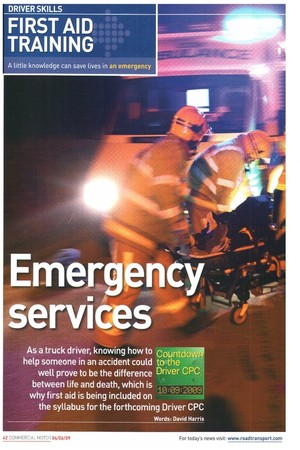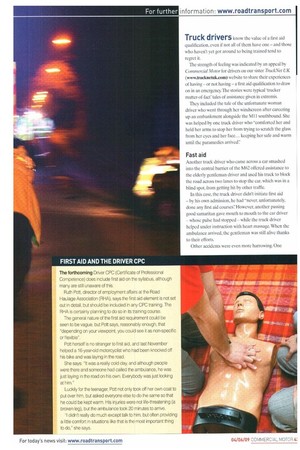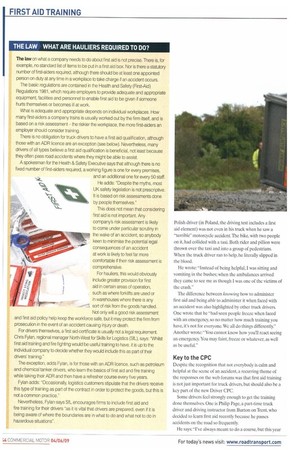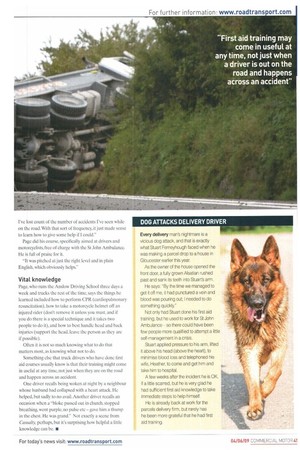Emer en
Page 42

Page 43

Page 44

Page 45

If you've noticed an error in this article please click here to report it so we can fix it.
As a truck driver, knowing how to cooidoM help someone in an accident could tythe
well. prove to be the difference Driver CPC between life and death, which is why first aid is being included on the syllabus for the forthcoming Driver CPC
Truck d rivers know the value of a first aid qualification, even if not all of them have one and tlio,.e who haven't yet got around to being trained tend to regret it.
The strength of feeling was indicated by an appeal by Commercial Motor for drivers on our sister TruckNet UK (vvww.trucknetuk.com) website to share their experiences of having or not havinga first aid qualification to draw on in an emergency. The stories were typical 'trucker matter-of-fact' tales of assistance given in extremis.
They included the tale of the unfortunate woman driver who went through her windscreen after careering up an embankment alongside the Ml I southbound. She was helped by one truck driver who -comforted her and held her arms to stop her from trying to scratch the glass from her eyes and her face... keeping her safe and warm until the paramedics arrived': Fast aid Another truck driver who came across a car smashed into the central barrier of the M62 offered assistance to the elderly gentleman driver and used his truck to block the road across two lanes to stop the car, which was in a blind spot, from getting hit by other traffic.
In this case, the truck driver didn't initiate first aid by his own admission, he had "never, unfortunately, done any first aid courses7However, another passing good samaritan gave mouth to mouth to the car driver whose pulse had stopped while the truck driver helped under instruction with heart massage. When the ambulance arrived, the gentleman was still alive thanks to their efforts.
Other accidents were even more harrowing. One Polish driver (in Poland, the driving test includes a first aid element) was not even in his truck when he saw a "terrible" motorcycle accident.The bike, with two people on it, had collided with a taxi. Both rider and pillion were thrown over the taxi and into a group of pedestrians. When the truck driver ran to help, he literally slipped in the blood.
He wrote: "Instead of being helpful,! was sitting and vomiting in the bushes; when the ambulances arrived they came to see me as though I was one of the victims of the crash."
The difference between knowing how to administer first aid and being able to administer it when faced with an accident was also highlighted by other truck drivers. One wrote that he "had seen people freeze when faced with an emergency, so no matter how much training you have, its not for everyone. We all do things differently." Another wrote: "You cannot know how you'll react seeing an emergency. You may faint, freeze or whatever, as well as be useful."
Key to the CPC
Despite the recognition that not everybody is calm and helpful at the scene of an accident, a recurring theme of the responses on the web forums was that first aid training is not just important for truck drivers, but should also be a key part of the new Driver CPC.
Some drivers feel strongly enough to get the training done themselves One is Philip Page, a part-time truck driver and driving instructor from Burton on Trent, who decided to learn first aid recently because he passes accidents on the road so frequently.
He says: "I've always meant to do a course, but this year I've lost count of the number of accidents I've seen while on the road. With that sort of frequency, it just made sense to learn how to give some help if I could."
Page did his course, specifically aimed at drivers and motorcyclists, free of charge with the St John Ambulance. He is full of praise for it.
"It was pitched at just the right level and in plain English, which obviously helps."
Vital knowledge
Page, who runs the Anslow Driving School three days a week and trucks the rest of the time, says the things he learned included how to perform CPR (cardiopulmonary resuscitation), how to take a motorcycle helmet off an injured rider (don't remove it unless you must, and if you do there is a special technique and it takes two people to do it), and how to best handle head and back injuries (support the head, leave the person as they are if possible).
Often it is not so much knowing what to do that matters most, as knowing what not to do.
Something else that truck drivers who have done first aid courses usually know is that their training might come in useful at any time, not just when they are on the road and happen across an accident.
One driver recalls being woken at night by a neighbour whose husband had collapsed with a heart attack. He helped, but sadly to no avail. Another driver recalls an occasion when a "bloke passed out in church. stopped breathing, went purple, no pulse etc — gave him a thump in the chest. He was grand." Not exactly a scene from Casualty, perhaps, but it's surprising how helpful a little knowledge can be. •
















































































































































